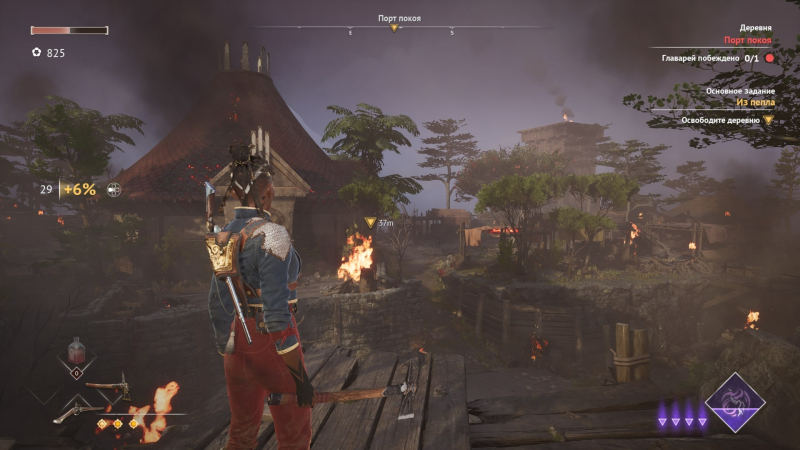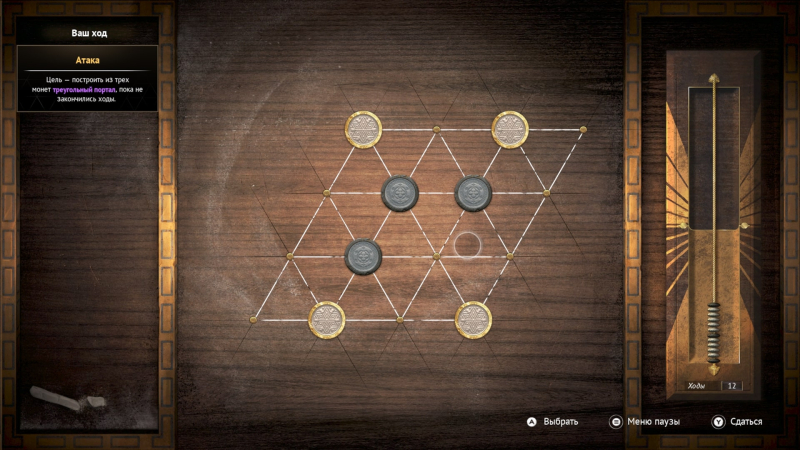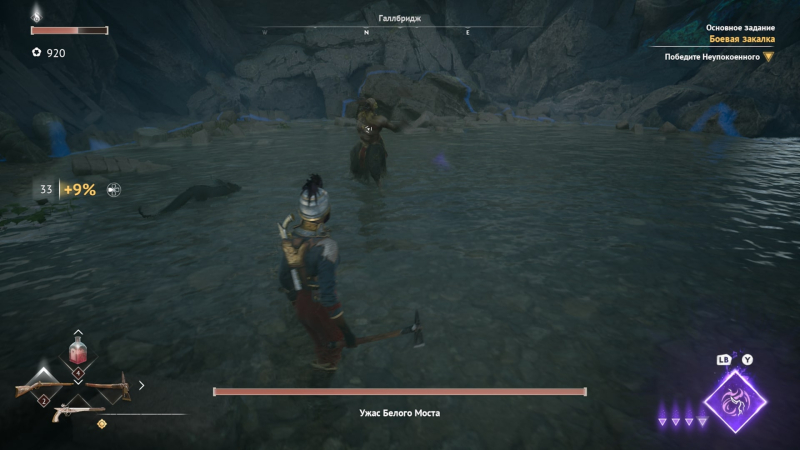Played on Xbox Series S
The team at A44 Games is still in love with the Dark Souls series – both its 2018 debut Ashen and the recent Flintlock are inspired by FromSoftware hits. Almost no one remembers Ashen now, but back then the action game stood out from other “soulful” clones: it looked original in appearance, the elaboration of small locations was impressive, and it was interesting to spend time with your partners. But Flintlock turned out to be somehow… ordinary. Banal. Surprisingly bland, despite the surroundings. There are a couple of great ideas here that could lift a mediocre game, but many of the elements are so boring that playing through it becomes a chore.
⇡#Together with you
We are transported to the Kian region, into which ten years ago hordes of the dead began to penetrate through the Gates of the Great Abyss. The Coalition detachment decided to put an end to the attacks of the evil spirits and tried to blow up the Gate, but the soldiers only made things worse – the defense was broken through, and the dead began to crawl throughout the world. Through its actions, the Coalition released the god Uru, the leader of the army of evil spirits, for whom we are hunting. We are the warrior-engineer Nor, who will be accompanied by the god Enki (in the guise of either a fox or a long-eared fennec cat).

Equipped items such as helmet and shoulder pads are displayed on the heroine
This is where the story, one might say, ends – then we will simply visit different areas of Kian and exchange a few phrases with people whom we will immediately forget about. The story is so crumpled and uninteresting that you wonder how it was possible to push the narrative so far into the background, having such an unusual surroundings on hand? Flintlock plays in the genre of so-called gunpowder fantasy: the characters are dressed as soldiers of the Napoleonic army, their arsenal includes muskets and cannons firing cannonballs, and the game’s scenery is similar to A Plague Tale with the same medieval buildings and general devastation against the backdrop of beautiful nature. At the same time, there is magic that the heroine uses with the help of her companion.
Although the relationship between Nor and Enki makes the story told a little less dull. Nor despises the gods, since because of them her people have been living in unbearable conditions for ten years (and will continue to live after the failure of the Coalition), and Enki understands her attitude and calmly takes attacks against her. Companions in such action games are commonplace: this happened in the aforementioned A Plague Tale, in the God of War reboot and in many other similar games. The scriptwriters did not reinvent the wheel: either the characters tease each other, or one explains something to the other about the structure of the world – in general, a mostly friendly atmosphere is created, and from these dialogues it is interesting to learn details about the lives of the characters.

Sometimes the game starts to “cosplay” Far Cry with captured villages that are transformed after being cleared of enemies
But otherwise you want to ignore the narrative, and it’s not like it’s trying to attract attention to itself – there are very few videos on the engine, and conversations, even with story characters, are very short. The authors of Flintlock seemed to be trying to work according to the FromSoftware template, but did not fully understand how the narrative element worked there. If the central storyline is not outstanding, then looking for clues and details about the world in the same Dark Souls is interesting – here the notes are boring (and with such a small font you don’t even want to read them), and everything else is not of interest. It was necessary to try to make the plot in such surroundings as passable as possible.
⇡#In pursuit of reputation
The gameplay is better, although much of Flintlock’s gameplay description could have been copied from any other Soulslick review without changing anything. We run around locations, hit enemies with melee weapons, we can block and parry their attacks, and also dodge by rolling. There are usually few opponents, but when there are more than three of them, it is better to lure them out one at a time. The beating here, of course, hurts, and in case of severe injury they allow you to use first aid kits – their number is limited. To restore supplies, we rest near the attraction stones – these are the local analogues of bonfires from Dark Souls. In this case, you improve your health and return the consumables you spent, but at the same time, killed enemies are reborn in the same places where they were before their death.

One of the sources of the reputation is the board game sebo, similar to tic-tac-toe. Gets bored right away
There are also differences from other soulslices. One of the main things is that the heroine has a pistol with several powder charges. You can shoot at an enemy and not only damage them, but also interrupt their attack, which is especially useful against piercing moves – those in which the enemy lights up red, indicating that such a strike cannot be parried or blocked. Over time, you gain access to other firearms, including a musket and a ricochet cannon – with them you can even aim and shoot at long distances. But such a weapon lies in another slot and sometimes you forget about it, and the pistol is an integral part of the equipment. Each of its charges is restored after four melee hits, and combinations of normal attacks and shots make fights spectacular and tense – you are constantly hoping that you can land a fourth hit and shoot before your opponent turns red.
Another interesting feature is the curses that Enki casts. By pressing the button, which is usually responsible for a strong attack, you direct the fox god towards the enemy – each of his blows little by little fills the scale above the opponent’s head (here it is called the preparation scale). When it is full, the enemy loses control of his body and can be dealt a critical attack. Subsequently, Enki will knock down armored enemies and lift opponents into the air, which can also be useful.

Enki can inflict negative effects even on bosses. It’s a pity, these bosses are mostly disappointing and sometimes don’t even feel like that
But the coolest feature of Flintlock has to do with its reputation. These are like souls in Dark Souls or currency in its clones – what you use to level up your character and buy equipment upgrades. You get reputation for defeating enemies, but it is not so important as its multiplier, which grows as you perform different actions. Just hitting an enemy increases the multiplier by 2%. They shot at him and added a couple more percent. Jumping strike, shooting on the run, attacking in a tackle, using Enki’s curses – there are a lot of opportunities to influence the multiplier. If you don’t fight with someone for a long time, the percentages don’t disappear anywhere – you can even run around with them endlessly and at any time, by holding down the button on the d-pad, multiply the number of reputation earned by the percentage. Because as soon as you take damage, the multiplier will reset.
The game doesn’t punish you too much for missing hits – you’ll still be given all the reputation you’ve collected, but it won’t be multiplied by anything. But those who play carefully and use their entire arsenal will earn nice bonuses if they press the d-pad in time. This is a very interesting mechanic that suggests you don’t go ahead and use all the first aid kits, but try to complete battles without taking damage.

When firing a musket, the camera follows the bullet, just like in Sniper Elite – but without the X-ray
The only problem is that Flintlock is not the best game for such mechanics. The combat system is okay, but not nearly as user-friendly as in many soulslices. Here you often catch a bullet from nowhere – it takes away a little health, but the multiplier resets, and every time it causes unpleasant emotions. In addition, you cannot interrupt animations, which is why you are constantly punished for trying to use different techniques – you cannot roll or parry an attack until the previous action is completed. This would look appropriate in another game, but here it doesn’t fit in with the reputation multiplier system – you want to increase it with different actions, but sometimes Flintlock seems to be against it.
The same can be said about world exploration – this aspect is also full of cool ideas that are not explored properly. The heroine has a double jump and is trained to dash in the air, and finding pedestals with skulls opens portals above the ground, between which you can jump with the help of Enki, getting to hard-to-reach places and unlocking shortcuts. All this is very funny, especially compared to other soulslicks, where the character is sometimes not even able to jump. But research very rarely leads to anything interesting. In most cases, you will either find armor that you will never use, or you will stumble upon wood, iron and sulfur that you need to upgrade your equipment. Useful, of course, but in other games such materials are in plain sight, and not hidden behind platform challenges, so disappointment awaits here at almost every corner.

Jumping between portals never gets boring, and there are quite a lot of them scattered around the world – you just need to find the skull keys
***
Flintlock looks like another game from independent developers who overestimated their strength. You can’t call her bad—it’s just that the phrase “another soulslice” suits her too perfectly. And this is a shame – the game has truly wonderful, original ideas, the successful implementation of which I would like to see not only in the team’s future projects, but also in other similar action games. However, no matter how interesting some of the mechanics here are, they don’t save you from the monotony and crookedness of the combat system, and they don’t make the plot interesting.
Advantages:
- Unusual surroundings with beautiful decorations;
- Sometimes funny dialogues between the main characters;
- Moving around the world is fun thanks to double jumping and portals;
- The currency earned multiplier is a great idea that rewards careful completion.
Disadvantages:
- The story is boring to the point of yawning;
- Crooked combat system, including due to the inability to interrupt animations;
- Monotonous structure and equally monotonous opponents;
- For exploring the world they are awarded uninteresting prizes.
Graphic arts
The game looks budget-friendly, in particular due to the “wooden” animations, but overall the picture turned out to be pleasant, also thanks to the surroundings.
Sound
The strangest thing about the sound here is the heart-rending screams of defeated enemies. Thanks to this game, “Wilhelm’s Scream” has many competitors. Otherwise, there is nothing to remember.
Single player game
Since there is, to put it mildly, no plot, only the combat system and exploration of the environment hold the screen – although they are not without their shortcomings.
Estimated time of completion
12 hours for the main story and another one or two evenings for side quests.
Collective game
Not foreseen.
General impression
Another soulslice in which great ideas are difficult to develop due to a mediocre plot, an inferior combat system and boring rewards for exploring the world.
Rating: 6.0 / 10
More about grading system
Video: